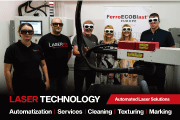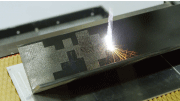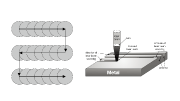Laser technology is steadily making its way to the forefront in many industries and other areas of our lives. It replaces traditional technologies and upgrades processing methods with energy efficiency, speed, low operation and maintenance costs, precision, better process repeatability and so on. At the same time, this technology, coupled with automation and robotization, introduces completely new processing methods that were previously not possible. At FerroČrtalič, we work hard to further accelerate the breakthrough of this technology.
Choosing The Right Technology
For the treatment of metal surfaces, the pulsed fiber laser technology is the most suitable, with a beam in the near-infrared (NIR) spectrum, at a wavelength of 1064 nm. The surface is treated with a fast-moving laser beam that pulses across the surface according to pre-set parameters.
When using pulsed fiber lasers in automatic and/or robotic applications, 2D or 3D laser solutions work best. It is a device that produces and conducts a laser beam – a pulse – through a fiber conductor, which is then directed to the surface via a movable mirror – scanner – through the laser lens.
With a 2D laser head, the beam covers the surface of the workpiece in the direction of two axes (X- and Y-axis) in pulses according to pre-set parameters and programmed movement paths. The size of the surface that the beam reaches without moving the head or the workpiece depends on the lens type choice. The size of the beam spot in the focal plane also changes by choosing a lens type that results in the different spot size and therefore also in the energy concentration of this spot.
The 3D laser head differs from the 2D head by having an additional lens that defines the third axis – Z-axis. This enables the laser to operate on slopes and objects with a stepped surface.
Advantages Of Automation And Robotization
At FerroČrtalič, as a long-standing player in the field of automated and robotic solutions for surface treatment, we were immediately won over by the many advantages of laser technology. More than 55 years of experience gives us the confidence to offer customers the best automated and robotic laser solutions for their challenges.
The advantages of automation and robotization of industrial processes are well known. Similarly, the automation and robotization of the laser application work process have considerable advantages over both traditional technologies and manual laser surface treatment solutions. Of course, it is necessary to emphasize that the laser cannot yet replace all the capabilities of traditional industrial surface treatment processes, but wherever this is possible, the transition to the laser is more than justified.
Safety
Safety and a healthy working environment are certainly two of the most important considerations in every work process. Regardless of the fact that the laser beam is fundamentally a dangerous thing, with an industrially automated or robotic application, the safety for the operator is increased compared to traditional solutions.
Laser Beam Safety Aspects
The current version of the main ANSI (The American National Standards Institute) Z136.1 Standard (Z136.1-2000) ranks lasers into one of four broad hazard classes (1, 2, 3a, 3b, and 4) depending on the potential for causing biological damage. Classification is determined by calculations based on exposure time, laser wavelength, and average power for CW (continuous wave) or repetitively pulsed lasers and total energy per pulse for pulsed lasers.
Given that all laser devices for the treatment of metal surfaces are classified as Laser Safety Class 4 (the same as the Roman numeral "Class IV" you may see on some lasers' labels), safety comes first. Class 4 lasers are hazardous for eye exposure and can also burn skin and materials, especially dark and/or lightweight materials at close range. As such, they should be used with extreme caution.
For visible-light lasers, Class 4 lasers have an output power of 500 milliwatts and above. There is no upper limit for Class 4 – this is the most hazardous laser classification.
Automation and robotization allow the operation of the laser beam to take place in a closed and controlled environment without potential hazards for injury to people and damage to equipment. These applications are classified as Class 1 laser solutions.
Working Environment
Characteristics
With Class 1 laser safety equipment, the working environment is 100% work-safe. Furthermore, unlike with the traditional technology, operators don't need to handle chemicals, wear protective equipment, and stop operations to replace consumables – the working environment is therefore not just safer but also much cleaner, and process cycles are faster.
Repeatability
Repeatability, or the ability to control the process in automated laser solutions, stands at practically 100%. The laser head is attached to a fixed location, a movable manipulator, or a robot. In addition to the programmability of all movement processes, the laser can also be programmed in terms of various parameters.
In the pulsed operation mode, short pulses are released at a set repetition rate. Pulsed laser beams reach higher peak powers and are ideal for laser engraving and laser cleaning. This mode includes the following parameters:
- Pulse energy: Pulse energy is the number of millijoules contained in each pulse. Typically, each pulse contains 1 mJ of energy. You can change the energy density by changing the spot size or decreasing the pulse energy.
- Pulse duration: Pulse duration, also known as pulse length or pulse width, is the duration of each pulse (the amount of time between the start of one pulse and the start of the next). Shorter pulses concentrate the same energy in a shorter amount of time and hence reach higher peak powers. Pulse duration can be expressed in microseconds, nanoseconds, picoseconds, or femtoseconds.
- Repetition rate: Pulse repetition rate is the number of pulses released per second. It is also known as pulse frequency, which is expressed in kHz, where 100 kHz is equal to 100,000 pulses per second.
In addition to the above parameters, the following parameters can also be set by computer:
- Working surface of the beam in terms of X- and Y-axis coordinates – surface boundaries within which the beam operates. By inputting a digital image, we define with great precision the boundaries and mode of operation of the laser beam. This way, it is possible to use high-resolution tags created from digital images (QR codes, logos, etc.) or to perform selective removal of paint, cleaning, or texturing, thereby avoiding protecting the areas that are not to be treated.
- Focal length – only 3D laser versions have the ability for the focal length to be computer-programmed. The focal length automatically changes during the process according to the programmed parameters. This is useful when the workpiece is made of surfaces at different levels. A defocus can also be used to enlarge the spot size, but one should keep in mind that the spot size increases very quickly when defocusing. The bigger the spot size, the lower the energy density.
- Spacing between individual pulses - depending on the desired effect, the pulses can overlap each other, or the distance between them may be greater than their diameter. The longer the distance between the pulses, the higher the processing speed.
- Distance between lines – in addition to the distance between individual points, we can also set the distance between lines, as the laser beam travels across the surface in straight lines.
By adding sensors to the application, we can enable real-time automatic checking of the quality of the process (image comparison), the readability of the engraved marks (traceability marks – QR codes, bar codes, etc.), and the process to be carried out on the fly. Each workpiece is thus processed in exactly the same way with a consistent and exactly predictable result.
Multiple Tasks In A Single Process
A single laser application can be adapted for a different type of laser treatment and for processing different workpieces, with very little or no manual intervention on the machine itself. One station can be used to perform various tasks. If the primary function of the device is laser cleaning, it is possible to combine it with laser marking for traceability purposes and with automatic video inspection of the quality of the process. One such example is the laser cleaning of battery contacts before joining and the simultaneous marking for traceability purposes. Also, we can do something similar with texturing. Another example of an interesting application is where, in one single step, the contact of two metal parts is laser-cleaned before welding, followed by welding itself and laser cleaning of the weld.
In short, there must be numerous combinations to implement into a single application with this technology.
Energy And Time Efficiency
Energy efficiency:
Surface treatments like abrasive blasting and chemical etching processes need abrasive media like steel grits or chemicals like acid to texture surfaces. Most of the time, these processes demand a large amount of compressed air to accelerate the abrasive or require the medium to be heated. Satisfying these needs requires a lot of energy.
With laser applications, the consumption of electricity is significantly lower. The working process of the laser beam and the fume extraction is very energy-efficient. There is no need for a powerful compressor, sizeable media filtering machine, or media heater.
Time efficiency:
With the flexibility that comes with precise programming of the parameters and the area of operation of the laser beam, time is also saved. We often find that only certain areas of the workpiece need to be treated, while the surrounding area must remain untreated. With traditional processes, this requires manual masking, which is a time-consuming and uncontrollable process.
Maintenance:
Unlike traditional treatments, the laser process functions without consumables and the beam works without physical contact that would cause abrasion or wear on the device's components, therefore maintenance and spare part expenses are indeed minimal.
To summarize: These are devices that, in the long term, bring significant improvements in various areas that affect production speed, product quality and employee health while providing a better environmental footprint of the company along with greater cost efficiency. At FerroČrtalič, we are ready to help all companies that are driven by a need for progress and a cleaner environment to discover the yet undiscovered possibilities of using fiber-laser technology for the treatment of metal surfaces.
For Information: FerroČrtalič d.o.o.
Sela pri Dolenjskih Toplicah 47
SI-8350 Dolenjske Toplice, Slovenia
Tel. +386.7.38 45 100
E-mail: sales@ferrocrtalic.com
































